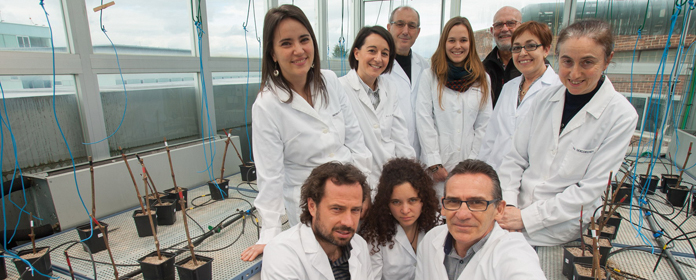Saving grapevines from climate change
A project of the University analyzes five clones of the tempranillo variety with a temperature increase of 4º and double the current CO2

PHOTO: Manuel Castells
(click on the image to enlarge)
The department of Environmental Biology of the University of Navarra has received 193,000 euros from the Ministry of Economics and Competitiveness (MINECO) - with the participation of the Wine Technology Platform (PTV) - to fight against the effects of climate change in one of the most widespread crops on the planet: the vine.
Currently, this group - who has been working on the effect of climate change on plants since 1995 - is focusing on the influence of rising temperature and CO2 on the tempranillo grape variety. "We chose tempranillo because it has many genetic variants, which we call clones, short-cycle and long-cycle. We tested different long-cycle clones because climate change shortens the ripening period of the grape," explains its manager, Professor Juan José Irigoyen. "Resorting to a variant of these characteristics can allow us to maintain the standards of balanced grape ripening in adverse conditions that, from average, we have established in an increase in temperature of 4º and a CO2 index almost double the current one, going from 400 PPM to 700 PPM", he points out.
The effect of the increase in temperature is palpable, and has meant that the grape harvests, which used to take place at the end of September or beginning of October, are now taking place a few weeks earlier. The increase in CO2 could also be involved in this advance, although, according to the expert, this has not been confirmed: "In the last 50 years CO2 has increased exponentially, but we still do not know the effect of both factors separately and combined in the development of the vine. That is our goal in the chamber greenhouses and thermal gradient greenhouses, where we analyzed the behavior of five clones of Tempranillo with an increase of 4 Degrees, both day and night", adds the researcher main project.
The Degree of alcohol could increase between 2 and 3 DegreesIn order for the wines to have the optimum characteristics , the grapes must reach a certain sugar content -which is what provides the Degrees alcohol- and a certain color. "Both characteristics occur at two different times of ripening in conditions of climate change, so that if the harvest is brought forward so that it has the desired alcohol content ( Degree ), it may lack color (between 15 and 30%). And vice versa, if you wait until it has the optimum color, it may accumulate too much sugar and, as a consequence, an increase in the alcoholic Degree of around 2 or 3 Degrees", explains Juan José Irigoyen.
For this reason, project focuses on the tempranillo variety, a variety with a shorter cycle than other varieties (hence its name) that are widely distributed in many wine-growing areas.
For the execution of the project, the group of Environmental Biology of the University of Navarra will count with the partnership of research center and development Tecnológico Agroalimentario de la Rioja (CIDA), the Experimental Station of classroom Dei of the CSIC, the high school of Vine and Wine Sciences (ICVV) and the University of Bordeaux-INRA. In addition, the group of Environmental Biology is part of the network Vitis, which includes ten relevant Spanish teams in the study of grapevine cultivation, led by Dr. Luis Gonzaga Santesteban, professor at the Public University of Navarra. This network, which brings together both research centers and universities, has a duration of two years and its main objective goal is to transfer its knowledge to companies in the sector.

